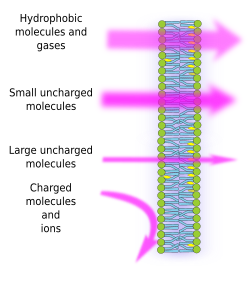Cellular Membranes Are Permeable to but Impermeable to
BImpereable to all solutes. Zinpyr-1 ZP1 is a fluorescein-based bright fluorescent sensor for divalent zinc that is cell permeable without prior modification.
The Cell 3 Cell Membrane Permeability Fluidity Atlas Of Plant And Animal Histology
The movement of ions or molecules across a cell membrane into a region of higher concentration assisted by enzymes and requiring energy.

. We describe here the synthesis and characterization of ZP1 sensors containing a carboxylic acid or ethyl ester functionality at the 5 or 6 position of the. These membranes are made of lipids phospholipids and cholesterol integral and peripheral proteins and carbohydrates glycolipids and glycoproteins that all interact with each other to form a barrier between the cell and its environment. Cellular membrane are permeable to the nutrients but impermeable to the salts.
The outer membrane surrounds the mitochondria. The term permeability in biology always refers to membranes. Hence third option is true as nutrients and salt.
It is a semi-permeable membrane similar to the cell membrane. Some membranes are selectively permeable allowing some substance to. C Impereable to 50 of any solutes in a solution.
Review from Google Play. The cell membrane is permeable to water but impermeable to solutes. Click to see full answer.
Esterification of fluorescent biosensors is a common strategy used to trap probes within the cell. O permeable O impermeable semi-impermeable selectively permeable Question 34 2p In a hypotonic cell condition which relates to the cell in its environment. An impermeable membrane is one in which a substance cannot pass through.
Other polar or charged particles are transported across the membrane by special embedded protein. To Keep Reading This Solution Download the APP. Depression of cell metabolism and proliferation by membrane-permeable and -impermeable modulators.
Classically there is a direct correlation between the lipophilic nature of a molecule and its rate of permeation across a biological membrane so cell membranes should be more permeable to small neutral molecules than they are to charged molecular species of similar size. They are not impermeable not letting anything pass nor are they freely permeable letting everything can pass. The inner membrane is impermeable.
Explore the definition and an explanation of impermeable. Impermeable membranes are tissues that do not allow substances to move through them. The Cell Will Shrink 14 Cell Membrane Transport Mechanisms And Permeability 1.
Role for AMP-to-ATP ratio Am J Physiol Regul Integr Comp Physiol. To facilitate the entry or export of molecules that are insufficiently permeable cells utilize membrane transporters the expression of which may depend on cell type. Cellular membranes are permeable to but impermeable to A nutrients wastes B from PHBM 355 at Duquesne University.
The cell membrane is usually permeable to a number of substances mostly small nonpolar molecules. Cell walls provide support and protection for plant cells. Solutes diffuse in water diffuses in crenation equilibrium.
Cell membrane is selectively permeable as it controls the movement of substances intoout of the cell. Some membranes are selectively permeable allowing some substances to pass through but not others. Additional info---Cells have membranes which are permeable to water diffusion but which do not allow the salts to pass.
Semipermeable vs Selectively Permeable Membranes. Not allowing fluid to pass through of cell membrane. What is the cell membrane freely permeable to.
An example of a permeable membrane in nature is the cell wall in plant cells. Which of the following is required for filtration. Active transporters use energy to translocate substrates against their concentration gradients whereas passive transporters allow transmembrane diffusion without additional energy.
Which refers to the characteristic of cell membranes. Question 23 1pts Cellular membranes are permeable to but impermeable to nutrients. Selective Permeability Cell membranes only allow some molecules through.
This characteristic is why cell membranes are selectively permeable. If the cell membrane becomes totally impermeable water and dissolved gases most notably oxygen would no longer be able to enter or leave the cell. If the intracellular concentration is 10 mM and the solution is 20 mM which of the following is true.
This quality allows a cell to control what enters and. Consequently the distribution of NH4 in biological systems is generally believed to be due to. An impermeable membrane is one in which a substance cannot pass through.
Biology questions and answers. What are cell membranes impermeable. The phospholipid bilayer the basic structural unit of biomembranes is essentially impermeable to most water-soluble molecules such as glucose and amino acids and to ions.
Up to 24 cash back A cell is immersed in a beaker of solution. The folds created by the inner membrane are known as the cristae which contain proteins and molecules that participate in cellular respiration. Learn vocabulary terms and more with flashcards games and other study tools.
Why Is The Cell Membrane Permeable To Lipid Soluble Molecules Quora
Why Is The Cell Membrane Permeable To Lipid Soluble Molecules Quora
Structures Of Cell Membrane Permeable And Impermeable Fluorogens Download Scientific Diagram

No comments for "Cellular Membranes Are Permeable to but Impermeable to"
Post a Comment